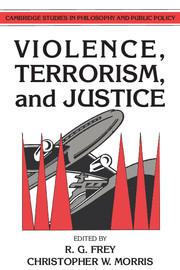Book contents
- Frontmatter
- Contents
- List of contributors
- Preface
- 1 Violence, terrorism, and justice
- 2 What purposes can “international terrorism” serve?
- 3 Violent demonstrations
- 4 Terrorism, rights, and political goals
- 5 The political significance of terrorism
- 6 Terrorism and morality
- 7 Which are the offers you can't refuse?
- 8 Making exceptions without abandoning the principle: or how a Kantian might think about terrorism
- 9 State and private; Red and White
- 10 State terrorism
- 11 Nuclear hostages
- 12 Rape as a terrorist institution
9 - State and private; Red and White
Published online by Cambridge University Press: 05 June 2012
- Frontmatter
- Contents
- List of contributors
- Preface
- 1 Violence, terrorism, and justice
- 2 What purposes can “international terrorism” serve?
- 3 Violent demonstrations
- 4 Terrorism, rights, and political goals
- 5 The political significance of terrorism
- 6 Terrorism and morality
- 7 Which are the offers you can't refuse?
- 8 Making exceptions without abandoning the principle: or how a Kantian might think about terrorism
- 9 State and private; Red and White
- 10 State terrorism
- 11 Nuclear hostages
- 12 Rape as a terrorist institution
Summary
PHILOSOPHY AND VIOLENCE: SOME ANXIETIES
This essay asks some quintessentially philosophical questions about violence and terrorism – is violence “special,” demanding a particular kind of moral treatment; can a state properly be called “terrorist”; is there anything worthwhile in the old radical distinction between “Red” and “White” terror? It begins with a prior question, whether philosophy has anything to contribute to the discussion of violence in the first place. The philosophical treatment of violence, and particularly of terrorist violence, suffers more than most political philosophy from a disproportion between the inevitable and proper impracticality of philosophical inquiry and the all-too-urgent practicality of the problems addressed. Every time the IRA blows an innocent family to pieces, and each time an Israeli reprisal raid on a Palestinian camp reduces a child to bloody rags, the life of reason is mocked, and the hope recedes of a politics based on debate and conciliation, a politics based, if you like, on “reflective equilibrium” rather than partisan passion. It is all too easy to see why an ordinary citizen, not otherwise ill disposed to intellectual activity, might question the point of a philosophical account of violence and terrorism. He or she would surely think a political sociology of terrorism was worth having; if it was soundly based, we might understand what drove the warring factions into violent conflict, and that might enable us to see the terms of a peace treaty, and how we might deflate their readiness to act violently.
- Type
- Chapter
- Information
- Violence, Terrorism, and Justice , pp. 230 - 255Publisher: Cambridge University PressPrint publication year: 1991
- 2
- Cited by

